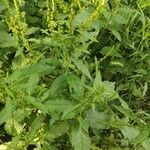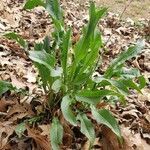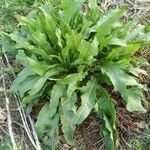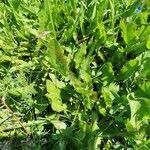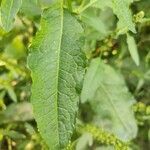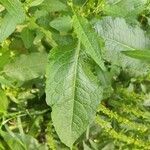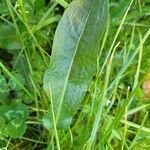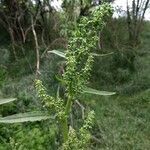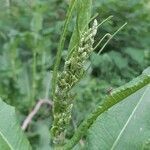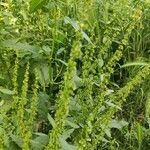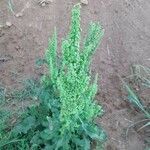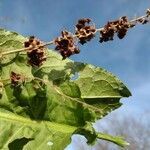Plants perennial, glabrous or very indistinctly papillose normally only on veins of leaf blades abaxially, with fusiform, vertical rootstock. Stems erect, branched from above middle, 80-150(-200) cm. Leaves: ocrea deciduous or partially persistent at maturity; blade ovate-lanceolate or oblong-lanceolate, normally 30-45(-50) × 10-15 cm, base truncate, broadly cuneate, or weakly cordate, margins entire, flat or weakly undulate, apex acute or subacute. Inflorescences terminal, occupying distal 1/ 2 of stem, normally dense, narrowly to broadly paniculate, branches usually straight or arcuate, rarely indistinctly flexuous. Pedicels articulated in proximal 1/3, sometimes almost near base, filiform, 5-13(-17) mm, articulation usually distinctly swollen. Flowers 10-20(-25) in whorls; inner tepals broadly ovate, suborbiculate, or orbiculate, (5-)5.5-8(-10) × 5-9(-10) mm, base usually distinctly cordate, margins entire or subentire to very weakly erose, apex obtuse or occasionally subacute; tubercles normally 1, more than 1 mm wide, normally less than 2 times as wide as inner tepals, occasionally 3, then 2 much smaller. Achenes brown, 3-3.5 × 1.5-2.5 mm. 2n = 60.
Herbs perennial. Roots vertical, large, to 3 cm in diam. Stems erect, 80-150(-200) cm tall, robust, branched above, grooved. Basal leaves: petiole 5-15 cm, stout; leaf blade oblong or oblong-lanceolate, 15-30 × 5-10 cm, base rounded, broadly cuneate, or subcordate, margin undulate, apex acute to subacute; cauline leaves shortly petiolate or nearly sessile, lanceolate, small; ocrea fugacious, 2-4 cm, membranous. Inflorescence paniculate, large. Flowers bisexual. Pedicel slender, articulate below middle, articulation swollen and slightly inflexed in fruit. Outer tepals oblong, ca. 1.5 mm; inner tepals enlarged in fruit; valves broadly cordate, 6-7 mm, all or 1 or 2 valves with narrowly ovate tubercles (in R. patientia s.str. normally 1 valve has a large tubercle, and two other valves have smaller tubercles), net veined, base deeply cordate, margin entire or indistinctly erose, apex obtuse. Achenes brown, shiny, ovoid, trigonous, 2.5-3 mm, apex acuminate. Fl. May-Jun, fr. Jun-Jul. 2n = 40.
A herbaceous perennial plant with a tough rootstock. It grows to 2 m tall. The leaves are long and sword shaped. They are 15-30 cm long by 4-15 cm wide. The upper leaves on the stem do not have leaf stalks. The flowers are small and green. The seeds are brown.
